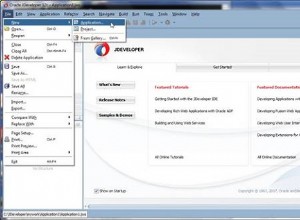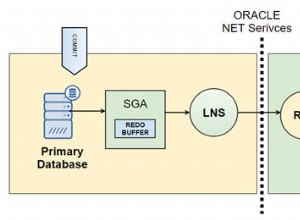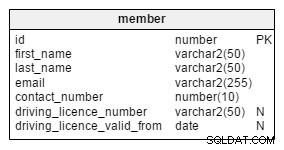Este código é bastante longo. Peço desculpas. Ele consiste em dois procedimentos armazenados. Você pode ficar satisfeito executando apenas o primeiro. O segundo usa a saída do primeiro (os dados que o primeiro deixou nas tabelas). Você também pode querer combinar o código em um. Mas eu os mantive separados. O segundo proc armazenado produz a saída para se parecer com
describe myTable . Mas ele executa para TODOS tabelas no banco de dados você deseja tal saída. Você usa isso passando um parâmetro (string) para o banco de dados relatar.
Eu crio um banco de dados separado e o código referencia explicitamente as tabelas nesse banco de dados por nome. Então, se você tiver
EXECUTE privilégios para este procedimento armazenado, você pode executá-lo de qualquer banco de dados atual. Portanto, como um teste simples, não defina o banco de dados de relatórios como seu banco de dados atual e simplesmente chame o procedimento armazenado pelo nome (qualificado com o nome do banco de dados de relatórios). Tudo isso é mostrado no trecho de teste abaixo. Dois procedimentos armazenados
CREATE SCHEMA Reporting101a; -- See **Note1**
DROP PROCEDURE IF EXISTS `Reporting101a`.`describeTables_v2a`;
DELIMITER $$
CREATE DEFINER=`root`@`localhost` PROCEDURE `Reporting101a`.`describeTables_v2a`(
IN dbName varchar(100), -- the dbname to report table structures
OUT theSession int, -- OUT parameter for session# assigned
IN deleteSessionRows BOOL, -- true for delete rows when done from main reporting table for this session#
IN callTheSecondStoredProc BOOL -- TRUE = output is from Pretty output in Second Stored Proc. FALSE= not so pretty output
)
BEGIN
DECLARE thisTable CHAR(100);
DROP TEMPORARY TABLE IF EXISTS Reporting101a.tOutput;
CREATE TEMPORARY TABLE Reporting101a.tOutput
( id int auto_increment primary key,
tblName varchar(100) not null,
ordVal int not null,
cField varchar(100) not null,
cType varchar(100) not null,
cNull varchar(100) not null,
cKey varchar(100) not null,
cDefault varchar(100) null,
cExtra varchar(100) null
);
DROP TEMPORARY TABLE IF EXISTS Reporting101a.tOutput2;
CREATE TEMPORARY TABLE Reporting101a.tOutput2
( tblName varchar(100) primary key,
colCount int not null,
cFieldMaxLen int not null,
cTypeMaxLen int not null,
cNullMaxLen int not null,
cKeyMaxLen int not null,
cDefaultMaxLen int not null,
cExtraMaxLen int not null
);
INSERT Reporting101a.tOutput(tblName,ordVal,cField,cType,cNull,cKey,cDefault,cExtra)
SELECT TABLE_NAME,ORDINAL_POSITION,COLUMN_NAME AS Field, COLUMN_TYPE AS TYPE, RPAD(IS_NULLABLE,4,' ') AS 'Null',
RPAD(COLUMN_KEY,3,' ') AS 'Key',RPAD(COLUMN_DEFAULT,7,' ') AS 'DEFAULT',EXTRA AS Extra
FROM information_schema.columns WHERE table_schema = dbName ORDER BY table_name,ordinal_position;
-- select * from information_schema.columns WHERE table_schema = '57security' order by table_name,ordinal_position;
UPDATE Reporting101a.tOutput
SET cExtra=' '
WHERE cExtra='';
UPDATE Reporting101a.tOutput
SET cField=RPAD(cField,5,' ')
WHERE LENGTH(cField)<5;
INSERT Reporting101a.tOutput2(tblName,colCount,cFieldMaxLen,cTypeMaxLen,cNullMaxLen,cKeyMaxLen,cDefaultMaxLen,cExtraMaxLen)
SELECT tblName,COUNT(*),0,0,0,0,0,0
FROM Reporting101a.tOutput
GROUP BY tblName;
UPDATE tOutput2 t2
JOIN
( SELECT tblName,MAX(LENGTH(cField)) AS mField,MAX(LENGTH(cType)) AS mType,MAX(LENGTH(cNull)) AS mNull,
IFNULL(MAX(LENGTH(cKey)),0) AS mKey,IFNULL(MAX(LENGTH(cDefault)),0) AS mDefault,IFNULL(MAX(LENGTH(cExtra)),0) AS mExtra
FROM Reporting101a.tOutput
GROUP BY tblName
) x
ON x.tblName=t2.tblName
SET t2.cFieldMaxLen=x.mField,t2.cTypeMaxLen=x.mType,cNullMaxLen=x.mNull,
cKeyMaxLen=x.mKey,cDefaultMaxLen=x.mDefault,cExtraMaxLen=x.mExtra;
-- DROP TABLE Reporting101a.reportDataDefsSession; -- useful for quick change of structure of table
-- note, keep above drop call remmed out ! Just use it for quick tweaks to structure
CREATE TABLE IF NOT EXISTS Reporting101a.reportDataDefsSession
( -- for the sole purpose of safe session auto_inc usage
-- Please don't delete unless you want the sessions to experience aberant behavior
sessionId INT AUTO_INCREMENT PRIMARY KEY,
dummy CHAR(1) NOT NULL,
creationDT datetime not null
);
CREATE TABLE IF NOT EXISTS Reporting101a.reportDataDefs
( sessionId INT NOT NULL,
tblName VARCHAR(100) NOT NULL, -- Tablename
ordVal INT NOT NULL, -- the "position number" of the Column
cField VARCHAR(100) NOT NULL, -- The Column
cType VARCHAR(100) NOT NULL, -- Datatype
cNull VARCHAR(100) NOT NULL, -- Nullability
cKey VARCHAR(100) NOT NULL, -- Key info
cDefault VARCHAR(100) NULL, -- Default value
cExtra VARCHAR(100) NULL, -- Extra output
colCount INT NOT NULL, -- the columns here and below are de-normalize data
cFieldMaxLen INT NOT NULL,
cTypeMaxLen INT NOT NULL,
cNullMaxLen INT NOT NULL,
cKeyMaxLen INT NOT NULL,
cDefaultMaxLen INT NOT NULL,
cExtraMaxLen INT NOT NULL
);
-- For lack of a better notion, we are calling calls "sessions". The programmer calls the
-- First Stored Proc, and we call that a session after we get a unique next incrementing number.
-- That number is the session #. House all output with that as a column value. This allows us to
-- move between stored procs, have safe output, have historical snapshots, and retain the data
-- via a session # for later use, whatever use.
INSERT Reporting101a.reportDataDefsSession(dummy,creationDT) VALUES ('X',now());
SET @mySession=LAST_INSERT_ID(); -- there it is, our session # (read the above paragraph)
INSERT Reporting101a.reportDataDefs(sessionId,tblName,ordVal,cField,cType,cNull,cKey,cDefault,cExtra,
colCount,cFieldMaxLen,cTypeMaxLen,cNullMaxLen,cKeyMaxLen,cDefaultMaxLen,cExtraMaxLen)
SELECT @mySession,t1.tblName,t1.ordVal,t1.cField,t1.cType,t1.cNull,t1.cKey,t1.cDefault,t1.cExtra,
t2.colCount,t2.cFieldMaxLen,t2.cTypeMaxLen,t2.cNullMaxLen,t2.cKeyMaxLen,t2.cDefaultMaxLen,t2.cExtraMaxLen
FROM Reporting101a.tOutput t1
JOIN Reporting101a.tOutput2 t2
ON t2.tblName=t1.tblName
ORDER BY t1.tblName,t1.id;
DROP TEMPORARY TABLE Reporting101a.tOutput;
DROP TEMPORARY TABLE Reporting101a.tOutput2;
SET [email protected]; -- the OUT var that came in as a parameter
-- ***************************************************************************
-- ***************************************************************************
-- Label "Some_Sort_of_Output":
IF callTheSecondStoredProc=TRUE THEN
-- The caller says to call the second stored proc (for Pretty Printing)
-- This will generate output similar to `DESCRIBE myTable`
-- But remember, it will do it for EVERY table in referenced database
CALL Reporting101a.`Print_Tables_Like_Describe`(@mySession);
-- The above call just gave you output.
ELSE
-- The caller chose to not auto call the Pretty Printing second stored procedure.
-- Note, the caller can easily call it right after using the OUT parameter.
-- So our output will be a resultset of out reportDataDefs table for this session #
SELECT *
FROM Reporting101a.reportDataDefs
WHERE [email protected]
ORDER BY tblName,ordVal;
END IF;
-- ***************************************************************************
-- ***************************************************************************
IF deleteSessionRows=TRUE THEN
-- The caller says output rows are NOT needed at this point. Delete them.
-- Note, if this boolean comes in TRUE, you can't call Pretty Printing
-- second stored procedure with the session # because the data is gone.
--
-- Regardless, you are getting something back from "Some_Sort_of_Output" above.
DELETE FROM Reporting101a.reportDataDefs
WHERE [email protected];
END IF;
END$$
DELIMITER ;
DROP PROCEDURE IF EXISTS `Reporting101a`.`Print_Tables_Like_Describe`;
DELIMITER $$
CREATE DEFINER=`root`@`localhost` PROCEDURE `Reporting101a`.`Print_Tables_Like_Describe`(
pSessionId INT
)
BEGIN
DECLARE done INT DEFAULT FALSE;
DECLARE curTable VARCHAR(100) DEFAULT '';
DECLARE bFirst BOOL DEFAULT TRUE;
DECLARE lv_tblName,lv_cField,lv_cType,lv_cNull,lv_cKey,lv_cDefault,lv_cExtra VARCHAR(100);
DECLARE lv_ordVal,lv_colCount,lv_cFieldMaxLen,lv_cTypeMaxLen,lv_cNullMaxLen,lv_cKeyMaxLen,lv_cDefaultMaxLen,lv_cExtraMaxLen INT;
DECLARE cur1 CURSOR FOR SELECT tblName,ordVal,cField,cType,cNull,cKey,cDefault,cExtra,
colCount,cFieldMaxLen,cTypeMaxLen,cNullMaxLen,cKeyMaxLen,cDefaultMaxLen,cExtraMaxLen
FROM Reporting101a.reportDataDefs
WHERE sessionId=pSessionId
ORDER BY tblName,ordVal;
DECLARE CONTINUE HANDLER FOR NOT FOUND SET done = TRUE;
-- Please note in the above, CURSOR stuff must come last else "Error 1337: Variable or condition decl aft curs"
CREATE TABLE IF NOT EXISTS Reporting101a.reportOutput
( lineNum INT AUTO_INCREMENT PRIMARY KEY,
sessionId INT NOT NULL,
lineOut varchar(100) NOT NULL
);
-- INSERT Reporting101a.reportOutput(sessionId,lineOut)
-- SELECT
-- SET curTable='';
DELETE FROM Reporting101a.reportOutput
WHERE sessionId=pSessionId;
OPEN cur1;
read_loop: LOOP
FETCH cur1 INTO lv_tblName,lv_ordVal,lv_cField,lv_cType,lv_cNull,lv_cKey,lv_cDefault,lv_cExtra,
lv_colCount,lv_cFieldMaxLen,lv_cTypeMaxLen,lv_cNullMaxLen,lv_cKeyMaxLen,lv_cDefaultMaxLen,lv_cExtraMaxLen ;
IF done THEN
LEAVE read_loop;
END IF;
IF lv_tblName<>curTable THEN
IF bFirst=FALSE THEN
INSERT Reporting101a.reportOutput(sessionId,lineOut)
SELECT pSessionId,'';
ELSE
SET bFirst=FALSE;
END IF;
INSERT Reporting101a.reportOutput(sessionId,lineOut)
SELECT pSessionId,lv_tblName;
INSERT Reporting101a.reportOutput(sessionId,lineOut)
SELECT pSessionId,CONCAT('+-',
REPEAT('-',GREATEST(5,lv_cFieldMaxLen)), '-+-',
REPEAT('-',GREATEST(4,lv_cTypeMaxLen)), '-+-',
REPEAT('-',GREATEST(4,lv_cNullMaxLen)), '-+-',
REPEAT('-',GREATEST(3,lv_cKeyMaxLen)), '-+-',
REPEAT('-',GREATEST(7,lv_cDefaultMaxLen)), '-+-',
REPEAT('-',GREATEST(5,lv_cExtraMaxLen)), '-+');
SET @dashLineNumRow=LAST_INSERT_ID();
INSERT Reporting101a.reportOutput(sessionId,lineOut)
SELECT pSessionId,CONCAT('| ',
'Field',
REPEAT(' ',GREATEST(0,lv_cFieldMaxLen-5)), ' | ',
'Type',
REPEAT(' ',GREATEST(0,lv_cTypeMaxLen-4)), ' | ',
'Null',
REPEAT(' ',GREATEST(0,lv_cNullMaxLen-4)), ' | ',
'Key',
REPEAT(' ',GREATEST(0,lv_cKeyMaxLen-3)), ' | ',
'Default',
REPEAT(' ',GREATEST(0,lv_cDefaultMaxLen-7)), ' | ',
'Extra',
REPEAT(' ',GREATEST(0,lv_cExtraMaxLen-5)), ' |');
INSERT Reporting101a.reportOutput(sessionId,lineOut)
SELECT pSessionId,lineOut
FROM Reporting101a.reportOutput
WHERE [email protected];
-- SELECT * FROM Reporting101a.reportDataDefs WHERE sessionId=24;
SET curTable=lv_tblName;
END IF;
INSERT Reporting101a.reportOutput(sessionId,lineOut)
SELECT pSessionId,
CONCAT('| ',
COALESCE(lv_cField,''),
COALESCE(REPEAT(' ',GREATEST(0,lv_cFieldMaxLen-LENGTH(lv_cField))),''),' | ',
COALESCE(lv_cType,''),
COALESCE(REPEAT(' ',GREATEST(0,lv_cTypeMaxLen-LENGTH(lv_cType))),''),' | ',
COALESCE(lv_cNull,''),
COALESCE(REPEAT(' ',GREATEST(0,lv_cNullMaxLen-LENGTH(lv_cNull))),''),' | ',
COALESCE(lv_cKey,' '),
COALESCE(REPEAT(' ',GREATEST(0,lv_cKeyMaxLen-LENGTH(lv_cKey))),''),' | ',
COALESCE(lv_cDefault,' '),
COALESCE(REPEAT(' ',GREATEST(0,lv_cDefaultMaxLen-LENGTH(lv_cDefault))),''),' | ',
COALESCE(lv_cExtra,' '),
COALESCE(REPEAT(' ',GREATEST(0,lv_cExtraMaxLen-LENGTH(lv_cExtra))),''),' |');
INSERT Reporting101a.reportOutput(sessionId,lineOut)
SELECT pSessionId,lineOut
FROM Reporting101a.reportOutput
WHERE [email protected];
END LOOP;
CLOSE cur1;
select lineOut as '' from Reporting101a.reportOutput where sessionId=pSessionId order by lineNum;
END$$
DELIMITER ;
Teste
Teste:
-- See **Note2**
SET @theOutVar =-1; -- A variable used as the OUT variable below
-- See **Note3**
-- Note: with `TRUE` as the 4th parameter, this is a one call deal. Meaning, you are done.
call Reporting101a.describeTables_v2a('stackoverflow',@theOutVar,false,true);
-- See **Note4**
-- Primarily used if the 4th parameter above is false
call Reporting101a.Print_Tables_Like_Describe(@theOutVar); -- loads data for prettier results in chunk format.
Saída
+--------------------------------------------------------------------------------------------+
| |
+--------------------------------------------------------------------------------------------+
| course |
| +------------+--------------+------+-----+---------+----------------+ |
| | Field | Type | Null | Key | Default | Extra | |
| +------------+--------------+------+-----+---------+----------------+ |
| | courseId | int(11) | NO | PRI | | auto_increment | |
| +------------+--------------+------+-----+---------+----------------+ |
| | deptId | int(11) | NO | MUL | | | |
| +------------+--------------+------+-----+---------+----------------+ |
| | courseName | varchar(100) | NO | | | | |
| +------------+--------------+------+-----+---------+----------------+ |
| |
| dept |
| +----------+--------------+------+-----+---------+----------------+ |
| | Field | Type | Null | Key | Default | Extra | |
| +----------+--------------+------+-----+---------+----------------+ |
| | deptId | int(11) | NO | PRI | | auto_increment | |
| +----------+--------------+------+-----+---------+----------------+ |
| | deptName | varchar(100) | NO | | | | |
| +----------+--------------+------+-----+---------+----------------+ |
| |
| scjunction |
| +------------+---------+------+-----+---------+----------------+ |
| | Field | Type | Null | Key | Default | Extra | |
| +------------+---------+------+-----+---------+----------------+ |
| | id | int(11) | NO | PRI | | auto_increment | |
| +------------+---------+------+-----+---------+----------------+ |
| | studentId | int(11) | NO | MUL | | | |
| +------------+---------+------+-----+---------+----------------+ |
| | courseId | int(11) | NO | MUL | | | |
| +------------+---------+------+-----+---------+----------------+ |
| | term | int(11) | NO | | | | |
| +------------+---------+------+-----+---------+----------------+ |
| | attendance | int(11) | NO | | | | |
| +------------+---------+------+-----+---------+----------------+ |
| | grade | int(11) | NO | | | | |
| +------------+---------+------+-----+---------+----------------+ |
| |
| student |
| +-----------+--------------+------+-----+---------+----------------+ |
| | Field | Type | Null | Key | Default | Extra | |
| +-----------+--------------+------+-----+---------+----------------+ |
| | studentId | int(11) | NO | PRI | | auto_increment | |
| +-----------+--------------+------+-----+---------+----------------+ |
| | fullName | varchar(100) | NO | | | | |
| +-----------+--------------+------+-----+---------+----------------+ |
| |
| testtable |
| +-----------------------------------------+---------------+------+-----+---------+-------+ |
| | Field | Type | Null | Key | Default | Extra | |
| +-----------------------------------------+---------------+------+-----+---------+-------+ |
| | noPKhere | int(11) | NO | | | | |
| +-----------------------------------------+---------------+------+-----+---------+-------+ |
| | veryLongColumnName_And_Then.Some_%_More | decimal(12,2) | YES | | | | |
| +-----------------------------------------+---------------+------+-----+---------+-------+ |
| | limit | int(11) | NO | | | | |
| +-----------------------------------------+---------------+------+-----+---------+-------+ |
| |
| testtable2 |
| +-------+---------+------+-----+---------+-------+ |
| | Field | Type | Null | Key | Default | Extra | |
| +-------+---------+------+-----+---------+-------+ |
| | id | int(11) | NO | PRI | | | |
| +-------+---------+------+-----+---------+-------+ |
+--------------------------------------------------------------------------------------------+
Nota1 :Um banco de dados chamado
Reporting101a é criado para abrigar dois procedimentos armazenados e algumas tabelas de suporte. Essas rotinas iniciam por uma chamada de procedimento armazenado referente ao banco de dados a ser relatado pelo uso de uma corda. Os dados para produzir a saída são acessados através do
INFORMATION_SCHEMA especial banco de dados de maneira segura somente para leitura. Assim, o banco de dados que está sendo relatado não é tocado. Existem três tabelas não temporárias mantidas neste banco de dados.
reportDataDefsSession- Uma tabela simples usada para obter uma sessão#reportDataDefs- dados retornados deINFORMATION_SCHEMAe massageado um pouco. É baseado em sessão.reportOutput- Uma tabela para impressão de impressão comoDESCRIBEdo MySQL . É apenas uma tabela para juntar a saída. É baseado em sessão.
Nota2 :Este
INT variável é incluída como um OUT parâmetro target, gravado e permite que você coloque seu outro código depois que o primeiro procedimento armazenado preparar os dados. Ele representa uma sessão # que isola a saída para relatórios posteriores. Alguns ambientes, como o PHP, têm certos truques que tornam isso um impedimento para alguns programadores. Portanto, se você precisar combinar os dois procedimentos armazenados por conta própria, faça-o (ou peça-me separadamente se estiver confuso).
De qualquer forma, ele mostra como dados ou esforços podem encadear chamadas de procedimento armazenado.
Honestamente uma das principais razões pelas quais eu saio com uma sessão # como um parâmetro OUT é que eu sei que tenho que criar um CURSOR para obter a saída bonita. E isso requer um
Cursor DECLARE
na parte superior de um segundo procedimento armazenado. E DECLARE s deve ocorrer na parte superior de um procedimento armazenado. Então, de mãos atadas, fui por esse caminho. Nota3 :esta é a chamada para o primeiro procedimento armazenado. É muito provável que você termine após esta chamada tendo TRUE como seu 4º parâmetro. O Stored Procedure está bem documentado dentro dele. O terceiro parâmetro é se você deseja ou não excluir os dados da tabela de relatórios para a sessão #. A exclusão ocorre após qualquer saída como um conjunto de resultados. Então, isso depende da sua escolha.
Parâmetros:
- o nome do banco de dados para descrever todas as tabelas como
describe myTable - o
INTOUTparâmetro para manter a sessão # - boolean:você deseja que os dados sejam excluídos da tabela de relatórios no final
- boolean:devemos chamar automaticamente o procedimento armazenado de impressão bonita que gera
describe-como saída. Se você decidir passar o parâmetro 4 comoFALSE, sua saída pode se parecer com isso:

Nota4 :Usado nos casos em que você deseja uma saída diferente, mas deseja que a sessão # funcione. Você normalmente não precisa disso.




